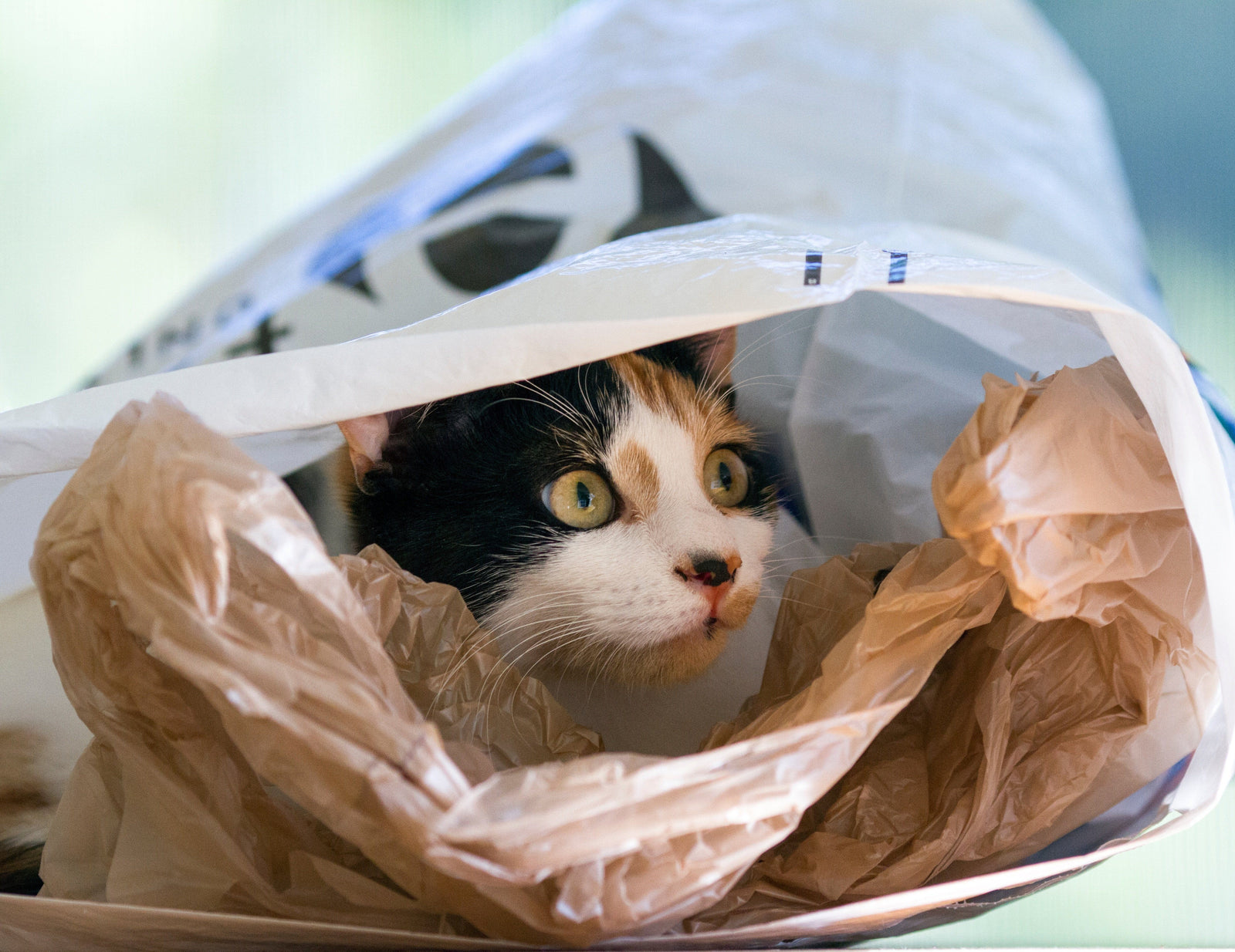
It can be scary to see your fur baby nibbling on something with child safety hazards printed all over it.Whether that's a grocery bag , a plastic cat toy,cords, or any other plastic item, cats seem to have an inexplicable attraction to theseinedible objects.If you’ve ever wondered, “why does my cat chew on plastic?”, we’re here to shed some light on this intriguing behavior.
After all, plastic isn’t exactly a nutritious feline snack, right?
Actually, plastic pica - a recurring behavior of eating or chewing onnon-food items such asplastic - is quite common in cats.
If your cat is nibbling on grocery bags, packing pillows, and shrink wrap, there may be an underlying reason - other than your cat being weird. As a cat owner, when should you be worried that this cat behavior has gone too far?
Here’s what could be causing your cat’s odd plastic habit.
Why Cats Eat Plastic
Cats are enigmas. Why they do anything is a mystery cat-parents love to ponder, mostly because the majority of your cat’s quirks are ridiculously cute. But eating plastic?
Not so cute.
In fact, it’s downright hazardous.
As a good cat owner, it’s up to you to get to the root of the cause and help your fur baby choose healthier options.
A Poor Cat Diet
Cats are highly instinctual animals, which means if they’re not getting something important in their diet,they may feel compelled to chew oninedible objects to fulfill their nutritional needs - even if it means eating plastic bags.
The best cat diet is one that is high in protein, moderate in fat, and super low in carbohydrates. Cats that are fed manufactured cat food that’s lacking the proper balance may seek out other sources of nutrition.
What to do: Take a look at your cat’s food. Look at the ingredients and make sure the first five are things you recognize. If you see the words “grain,” “byproduct,” or any other harmful pet food ingredients, toss it. Instead, opt for premium cat food that lists healthy protein and fat sources - like chicken, fish, turkey, liver, and eggs - in the first 5 ingredients. As a general rule, the fewer ingredients, the better for your cat’s diet.
Stress
As cool as they come off, cats don’t handle stress well. Unfortunately, there’s a lot that can stress your cat out
Like too much attention from the kids, not enough attention from you, being bullied by another cat in the house, not having enough stimulation or play time, or hidden illnesses. This can lead your cat to seek out anything soothing, which may include hiding in dark, quiet places, scratching your favorite curtains, or eating things she shouldn’t.
Chewing on plastic objects may provide some relief for cats, but it is crucial to provide appropriate alternatives, such as chew toys, and monitor their behavior closely to prevent any potential hazards.
What to do:
- Start by reading our guide to cat stress.
- Rule out any possible stressors in your cat’s environment and do what you can to make your cat feel at ease.
- Provide plenty of interactive toys, scratching posts, and playtime to keep your cat mentally and physically stimulated.
- If your cat continues to pursue the plastic, get your cat a checkup. Many cats will experience stress due to a health problem, even if they don’t show any other signs of being ill.
Curiosity
If you just started noticing your cat eating plastic, it may not be a cause for concern yet. Cats are naturally curious, and, like kids, they’ll lick, bite, and chew on just about anything. When your cat encounters a plastic bag or plastic toy, their instincts tell them to explore it through chewing.
What to do: Keep an eye on it. If your cat and plastic end up in the same frame multiple times, or if you start finding kitty tooth marks on your plastic goods, then it may be time to rule out other options.
Also, give your cat toys and other places to explore in the house. Some cats have a strong predatory drive and just need that itch scratched with fun toys and laser beams that make them feel like they’re on the prowl.
An Underlying Health Problem
Cats are self-soothers. They prefer to make themselves feel better before letting anyone else know that they’re unwell.
Nibbling on plastic might be your cat’s way of trying to make themself feel better when an underlyingmedical condition hasthem feeling under the weather. Cats suffering from anemia,dental disease, diabetes, brain tumors, hyperthyroidism, and immune system deficiencies can exhibit pica behaviors.
What to do: Make an appointment with your vet. Many cat health conditions can be treated or even cured if they’re caught early. If you’ve ruled out other possibilities for your cat’s bizarre behavior, let a vet take a look.
If you’re using PrettyLitter, make sure you’re checking the color of the litter every day. While PrettyLitter can’t detect every cat health problem under the sun, it can point out when something’s not quite right and is an excellent tool for keeping tabs on your kitty’s internal health.
Why Plastic?
Of all things, why plastic? It seems as though cats could seek out any other substance - cardboard, cloth, even human food - to munch on, but no. They choose to go for the plastic.
Why?
This question remains a mystery, but there are a few theories floating around.
Craving Crinkles
Some cats enjoy the sound of crinkling. They just love that particular sound, whether it’s crinkling paper, crinkling foil, or crinkling plastic.
To see if this is what’s driving your cat’s mad munchies, givethemsomething else (read: safer) to chew on that crinkles. We like this crinkle stick that your cat can cuddle, carry, chase, or chew to satisfy that crazy craving.
Craving Animal Products
If your cat prefers flimsy plastic, like what your grocery bags are made of,theymay be craving some animal fat. Some grocery bags are made with animal by-products like gelatin. Your cat may be looking for something to satisfy that primal carnivore craving.
Something Else
Full disclosure: this puzzle has yet to be solved. We may never fully understand why cats seem to prefer plastic over all other substances. But we highly recommend you keep asking them.
And let us know if you get an answer.
If you’re like us and you’ve been stumped as to why cats eat plastic, we hope this has cleared up some of the confusion.



Follow Us